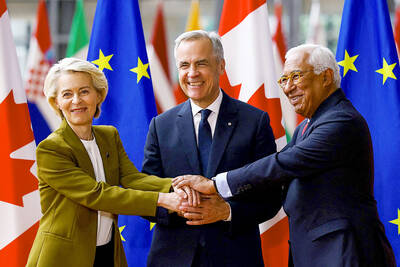When Jin Xin first started selling imported premium beer a decade ago, his bar manager predicted that it would take several months just to sell a single case. However, within a few years business picked up and soon customers started frequenting the bar for its India pale ales and other European beers.
Now, one of Jin’s bars, NBeerPub, tucked away in a laid-back part of Beijing’s old town, buzzes with young Chinese customers ordering imported beers such as Delirium Tremens, Lindemans Framboise and Brewdog Punk IPA.
Jin even sold a bottle of Brewmeister Snake Venom, a high-alcohol barleywine-style beer from Scotland, for about 2,700 yuan (US$639.74).
“Slowly, Chinese people have more money in their pocket,” Jin said in his apartment, where more than 6,000 bottles from more than 60 countries filled the shelves. “After they have money, some want something better in terms of taste as well as lifestyle, especially young people.”
As tastes rapidly change, Chinese consumers are swapping mass-produced local beers for imports and local craft beers.
It is the type of opportunity that is at the heart of Anheuser-Busch InBev’s US$106 billion deal to buy SABMiller. While major markets in Europe and the US have been sluggish, developing markets such as China offer a growing customer base and the potential for a stronger profit.
In China, Anheuser-Busch InBev and SABMiller are betting on premium products.
The two beer giants were among the first international entrants into China in the 1990s and initially teamed up with local brewers. At the time, domestic breweries produced beer of inconsistent quality, but they were quickly multiplying and consumption was soaring along with disposable incomes.
SABMiller took a 49 percent stake in a joint venture that makes Snow — China’s best-selling beer brand. Anheuser-Busch InBev has since bought Harbin and Sedrin, two other top domestic brands. Together, the international brewers account for about one-third of the overall beer market in China.
As they pursue a merger, given their dominance, Anheuser-Busch InBev and SABMiller are expected to prune their portfolio in China to keep regulators happy, although it remains unclear where the trimming would be done.
Some analysts think they would be able financially to justify the sale of a big domestic brand such as Snow, since the market is moving toward premium offerings.
“They might be forced to divest, but it might not be the end of the world for them, because Snow is not necessarily the price point for them,” Shanghai-based China Market Research founder Shaun Rein said. “Consumers are looking for better quality.”
When the deal was announced, Anheuser-Busch InBev said it would “promptly and proactively” resolve any regulatory issues in China.
The focus follows the shift in the Chinese market in recent years.
Imports have swiftly grown to 1.4 billion yuan in 2013, from 335 million yuan in 2009. However, the total volume of beer sales in China has dipped of late.
Homegrown craft beers are gaining favor. Beijing is home to about half a dozen microbreweries and others have popped up in cities across China.
At the Jing-A Brewing Taproom in Beijing, the owners, originally from Connecticut and Toronto, serve US-inspired beers with local flare, including Worker’s Pale Ale, Airpocalypse Double IPA and Mandarin Wheat.
Ji Chen said he developed a taste for fine beer as a student in Belgium. When he returned to China, Chen, now 28, started buying imported beer at the supermarket and hanging out at brew pubs.
“I don’t think it’s expensive,” he said, sipping the Flying Fist IPA at Jing-A. “If you go out to drink at a bar, you would have to spend this much for any drink you get and craft beers here are of good quality.”
The high-end varieties can fatten a company’s bottom line.
More than 30 percent of sales under the Snow brand are in the premium segment, including Snow Draft and Snow Brave the World, according to SABMiller’s annual report. The brands Anheuser-Busch InBev markets as premium in China, which include Budweiser, Corona, Stella Artois and Hoegaarden, make up nearly a quarter of its sales by volume.
“All of this premiumization and trading up is the biggest revenue driver of our industry,” Anheuser-Busch InBev China president Jean Jereissati said at an investor seminar in September last year. “It is very relevant for our company.”
The message is getting through to consumers, who are increasingly willing to pay for beer.
At Heaven Supermarket, a store and bar with a backpacker vibe, Chen Jing, 30, browsed through the imported beer with her boyfriend, both of them clutching beers that cost about 50 yuan. A bottle of Snow from the grocery store next door cost just 1.9 yuan.
Most of the bottles going through the checkout at Heaven are overseas varieties like Hoegaarden, Corona and Budweiser, selling for 15 yuan. The store, across the road from a Rolls-Royce and Bentley dealership, is not short of people perusing more expensive beers, which can cost up to 100 yuan.
Chen started drinking foreign beer after vacationing around China and Southeast Asia. She has taken such a liking to the beer culture that she is planning a holiday in Belgium.
“I would rather be spending money on few quality beers than buying lots of cheap beers and feeling full and headachy,” she said. “It’s more about the lifestyle I choose than simply drinking.”

The team behind the long-awaited Vera Rubin Observatory in Chile yesterday published their first images, revealing breathtaking views of star-forming regions as well as distant galaxies. More than two decades in the making, the giant US-funded telescope sits perched at the summit of Cerro Pachon in central Chile, where dark skies and dry air provide ideal conditions for observing the cosmos. One of the debut images is a composite of 678 exposures taken over just seven hours, capturing the Trifid Nebula and the Lagoon Nebula — both several thousand light-years from Earth — glowing in vivid pinks against orange-red backdrops. The new image

Canada and the EU on Monday signed a defense and security pact as the transatlantic partners seek to better confront Russia, with worries over Washington’s reliability under US President Donald Trump. The deal was announced after a summit in Brussels between Canadian Prime Minister Mark Carney and European Commission President Ursula von der Leyen and European Council President Antonio Costa. “While NATO remains the cornerstone of our collective defense, this partnership will allow us to strengthen our preparedness ... to invest more and to invest smarter,” Costa told a news conference. “It opens new opportunities for companies on both sides of the

ESPIONAGE: The British government’s decision on the proposed embassy hinges on the security of underground data cables, a former diplomat has said A US intervention over China’s proposed new embassy in London has thrown a potential resolution “up in the air,” campaigners have said, amid concerns over the site’s proximity to a sensitive hub of critical communication cables. The furor over a new “super-embassy” on the edge of London’s financial district was reignited last week when the White House said it was “deeply concerned” over potential Chinese access to “the sensitive communications of one of our closest allies.” The Dutch parliament has also raised concerns about Beijing’s ideal location of Royal Mint Court, on the edge of the City of London, which has so

OVERHAUL: The move would likely mark the end to Voice of America, which was founded in 1942 to counter Nazi propaganda and operated in nearly 50 languages The parent agency of Voice of America (VOA) on Friday said it had issued termination notices to more than 639 more staff, completing an 85 percent decrease in personnel since March and effectively spelling the end of a broadcasting network founded to counter Nazi propaganda. US Agency for Global Media (USAGM) senior advisor Kari Lake said the staff reduction meant 1,400 positions had been eliminated as part of US President Donald Trump’s agenda to cut staffing at the agency to a statutory minimum. “Reduction in Force Termination Notices were sent to 639 employees at USAGM and Voice of America, part of a